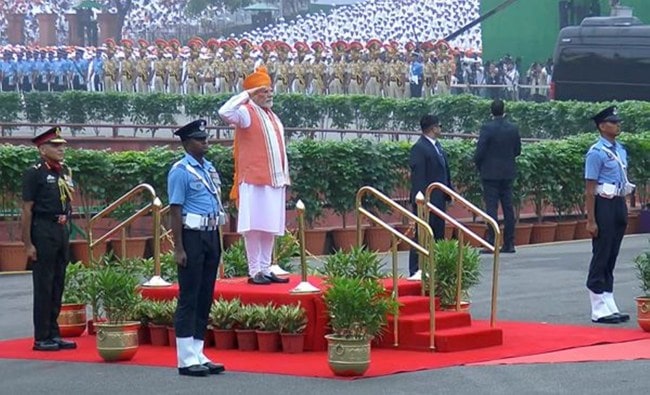Opinion Make in India push in PM Modi’s I-Day speech reflects tactical response to rising protectionism and tariff wars
The emphasis on "vocal for local" and "swadeshi" manufacturing creates a virtuous cycle where domestic preference drives scale, scale drives competitiveness, and competitiveness enables global market penetration
 By building on domestic demand, countries can grow industrial capabilities that are both globally competitive and domestically rooted, providing resilience against external shocks while maintaining growth momentum.
By building on domestic demand, countries can grow industrial capabilities that are both globally competitive and domestically rooted, providing resilience against external shocks while maintaining growth momentum. On August 15, 2025, Prime Minister Narendra Modi delivered a landmark speech that went beyond nostalgia, framing a vision directly attuned to today’s economic realities. His call for “daam kam, dum zyada” (lower price, higher quality) is more than a slogan — it is a tactical response to a global environment marked by rising protectionism and tariff wars, which are forcing nations to rethink their economic strategies.
While India pursued export-led growth through special economic zones, trade agreements, and production clusters geared toward international markets, the emphasis is now also shifting towards supply-chain reforms, infrastructure upgrades, and financial support being reoriented to serve Indian consumers first. This pivot ensures that India’s growth narrative is increasingly defined by its existing strong point as a consumption-driven economy rather than an export-dependent one. Private consumption accounted for over 61.4 per cent of GDP in FY2025, reaching levels not witnessed in two decades. Unlike countries highly reliant on export markets, vulnerable to external shocks and geopolitical changes, India’s economic resilience is underpinned by the spending power of its 1.4 billion citizens.
Further strengthening this foundation is India’s demographic advantage. Over half the population is under 30 years old, and the middle class is projected to add 75 million middle-income and 25 million affluent households by 2030, making these segments 56 per cent of the population. This growing affluence fuels consumption-led industrial capacity, which in turn generates jobs and raises income, perpetuating positive growth cycles.
Central to Modi’s strategy is the Production Linked Incentive (PLI) scheme, designed to leverage this huge domestic market into global manufacturing strength. The PLI programme is reported to have attracted investments worth Rs 1.76 lakh crore, created lakhs of jobs, and boosted exports. Electronics manufacturing is a standout example, with smartphone exports surging as India shifts from a net importer to a significant exporter in the domain.
The unique feature of PLI lies in its incentive structure with rewards tied to incremental sales of locally made goods, encouraging companies to build scale that serves both domestic and international markets. This model moves away from traditional low-cost export strategies and instead builds on India’s vast consumption base to achieve economies of scale, driving down costs while improving quality.
This focus on scale and quality also underpins the semiconductor industry’s rapid growth – India’s first domestically made semiconductor chips are expected by the end of 2025. Investments by firms like Micron and Tata Electronics are laying the groundwork for fabrication facilities primarily serving an electronics market hungry for self-sufficiency.
The country is also set to increase nuclear energy capacity tenfold by 2047 through the construction of 10 reactors. Complementing this are missions to explore deepwater energy resources and expand renewable infrastructure, including hydro and solar power. A strategic highlight is the National Critical Minerals Mission, aiming to fill gaps in lithium, cobalt, and rare earth supply chains, crucial to India’s electric vehicle and renewable ambitions amid global resource nationalism.
However, India’s path is not without challenges. Structural issues like infrastructural bottlenecks, regulatory hurdles, and shortages of skilled labour threaten to inhibit rapid scaling unless addressed urgently. Reforms beyond tariffs and subsidies, towards fostering dynamic comparative advantages, remain imperative. While digital innovations like UPI and the JAM trinity showcase India’s inventive capacity, replicating such success in manufacturing demands consistent policy support and efficient execution.
The Make in India 2.0 framework that emerged from the Prime Minister’s Independence Day speech underlines that rather than competing solely on low costs, India is positioning itself to compete on value proposition — combining reasonable costs with high quality, technological sophistication, and innovative solutions. The emphasis on “vocal for local” and “swadeshi” manufacturing creates a virtuous cycle where domestic preference drives scale, scale drives competitiveness, and competitiveness enables global market penetration.
This approach proves particularly relevant as global supply chains fragment and countries prioritise supply security over cost optimisation. Additionally, the decade-long Mission Sudarshan Chakra aims to defend India’s civilian, strategic, and religious sites using indigenous technology by 2035. This initiative matches the vision of technological sovereignty, mirroring the broader imperative to cut foreign dependencies.
Modi also emphasised the need to reduce dependency on imported fertilisers — a key step in consolidating agricultural self-reliance. India’s agricultural sector, while facing challenges from global price volatility and climate change, benefits from the expanding food processing market. The procurement of millets by PLI beneficiaries has shown significant improvement, demonstrating how domestic manufacturing can support agricultural transformation.
As India approaches the centennial of its independence in 2047, its economic strategy represents a maturation of the country’s development thinking, where it is building comprehensive domestic capabilities that enable it to engage with the world from a position of strength.
Finally, by building on domestic demand, countries can grow industrial capabilities that are both globally competitive and domestically rooted, providing resilience against external shocks while maintaining growth momentum. India’s journey toward Viksit Bharat 2047 demonstrates that economic sovereignty and global competitiveness are not contradictory objectives but complementary strategies in an increasingly uncertain world.
The writer is Fellow and Lead, Centre for New Economic Diplomacy, Observer Research Foundation




